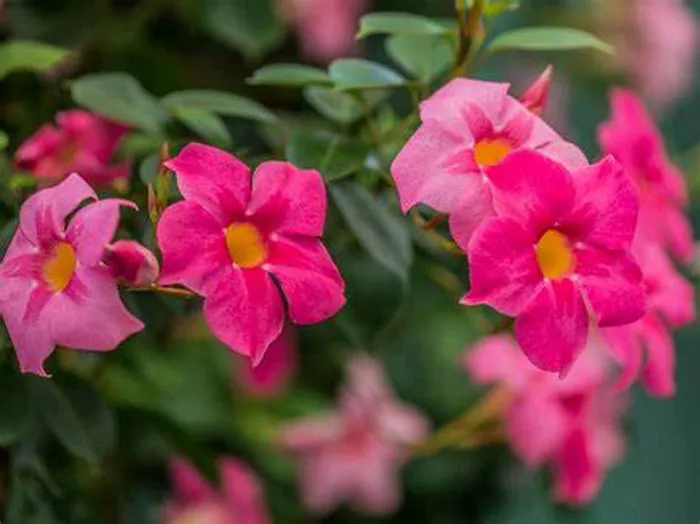Mandevilla flowers, with their vibrant hues and striking appearance, have long captivated gardeners and flower enthusiasts alike. These exquisite blooms, native to South America, belong to the genus Mandevilla and are renowned for their stunning trumpet-shaped blossoms and glossy green foliage. In this comprehensive guide, we delve into the captivating world of Mandevilla flowers, exploring their appearance, varieties, cultivation, and care.
Appearance and Characteristics
Mandevilla flowers are renowned for their striking appearance and captivating beauty. These showy blossoms typically feature trumpet-shaped blooms that can measure anywhere from two to five inches in diameter. The flowers exhibit a wide array of vibrant colors, including shades of pink, red, white, and yellow, often with contrasting throats or centers.
One of the defining features of Mandevilla flowers is their glossy, dark green foliage, which serves as an elegant backdrop to the colorful blooms. The leaves are generally ovate or lanceolate in shape, with a leathery texture and prominent veins.
Mandevilla plants are vigorous climbers, equipped with twining stems that allow them to scale trellises, arbors, and other supporting structures with ease. This climbing habit makes them an ideal choice for adding vertical interest to gardens, patios, and balconies.
Varieties of Mandevilla Flowers
The genus Mandevilla encompasses several species and numerous cultivated varieties, offering a diverse range of flower colors, sizes, and growth habits. Some popular Mandevilla cultivars include:
1. Mandevilla sanderi: Also known as Dipladenia, this species is prized for its compact growth habit and prolific flowering. It typically produces smaller flowers in shades of pink, red, or white.
2. Mandevilla × amabilis: This hybrid variety is a cross between different Mandevilla species, resulting in larger flowers and a wider range of colors. It is known for its vigorous growth and abundant blooms.
3. Mandevilla boliviensis: Native to Bolivia, this species is characterized by its pendulous growth habit and elegant, tubular flowers. The blossoms are typically white or pale yellow, with a delicate fragrance.
4. Mandevilla laxa: Also known as Chilean Jasmine, this species is prized for its fragrant, star-shaped flowers and vigorous climbing habit. The blossoms are usually white or pale pink and emit a sweet, jasmine-like scent.
These are just a few examples of the many Mandevilla varieties available to gardeners. Each cultivar offers its own unique blend of characteristics, allowing individuals to select the perfect Mandevilla for their specific preferences and growing conditions.
Cultivation and Care
Growing Mandevilla flowers successfully requires careful attention to their specific cultural needs. Here are some essential tips for cultivating and caring for these exquisite blooms:
1. Light: Mandevilla plants thrive in bright, indirect light. Ideally, they should receive at least six hours of sunlight per day. However, they should be protected from intense midday sun, which can scorch their delicate foliage.
2. Temperature: Mandevilla flowers are tropical plants that prefer warm temperatures. They thrive in temperatures ranging from 65 to 80 degrees Fahrenheit (18 to 27 degrees Celsius). Avoid exposing them to temperatures below 50 degrees Fahrenheit (10 degrees Celsius), as they are sensitive to cold.
3. Watering: Proper watering is essential for Mandevilla plants. Keep the soil consistently moist but not waterlogged. Allow the top inch of soil to dry out between waterings, and avoid letting the plant sit in standing water, as this can lead to root rot.
4. Fertilization: Feed Mandevilla plants regularly during the growing season with a balanced fertilizer formulated for flowering plants. Apply fertilizer every two weeks to promote healthy growth and abundant blooming.
5. Support: Since Mandevilla plants are climbers, provide them with a sturdy support structure such as a trellis, arbor, or fence. This will allow them to climb and flourish, showcasing their beautiful blooms.
6. Pruning: Prune Mandevilla plants as needed to control their growth and shape. Remove any dead or damaged foliage, as well as spent flowers, to encourage continuous blooming throughout the growing season.
7. Overwintering: In regions with cold winters, Mandevilla plants can be overwintered indoors to protect them from freezing temperatures. Bring potted plants indoors before the first frost, and place them in a bright, cool location. Reduce watering during the winter months, and resume regular care in the spring.
By providing Mandevilla flowers with the proper growing conditions and care, gardeners can enjoy their spectacular blooms year after year.
Conclusion
Mandevilla flowers are cherished for their stunning appearance, vibrant colors, and graceful climbing habit. Whether grown as a focal point in the garden, a container plant on the patio, or a charming accent indoors, these exquisite blooms never fail to impress with their beauty and elegance. With the right cultivation and care, Mandevilla plants reward gardeners with a profusion of blossoms that brighten any outdoor or indoor space. Embrace the allure of Mandevilla flowers and add a touch of tropical splendor to your garden or home today.


